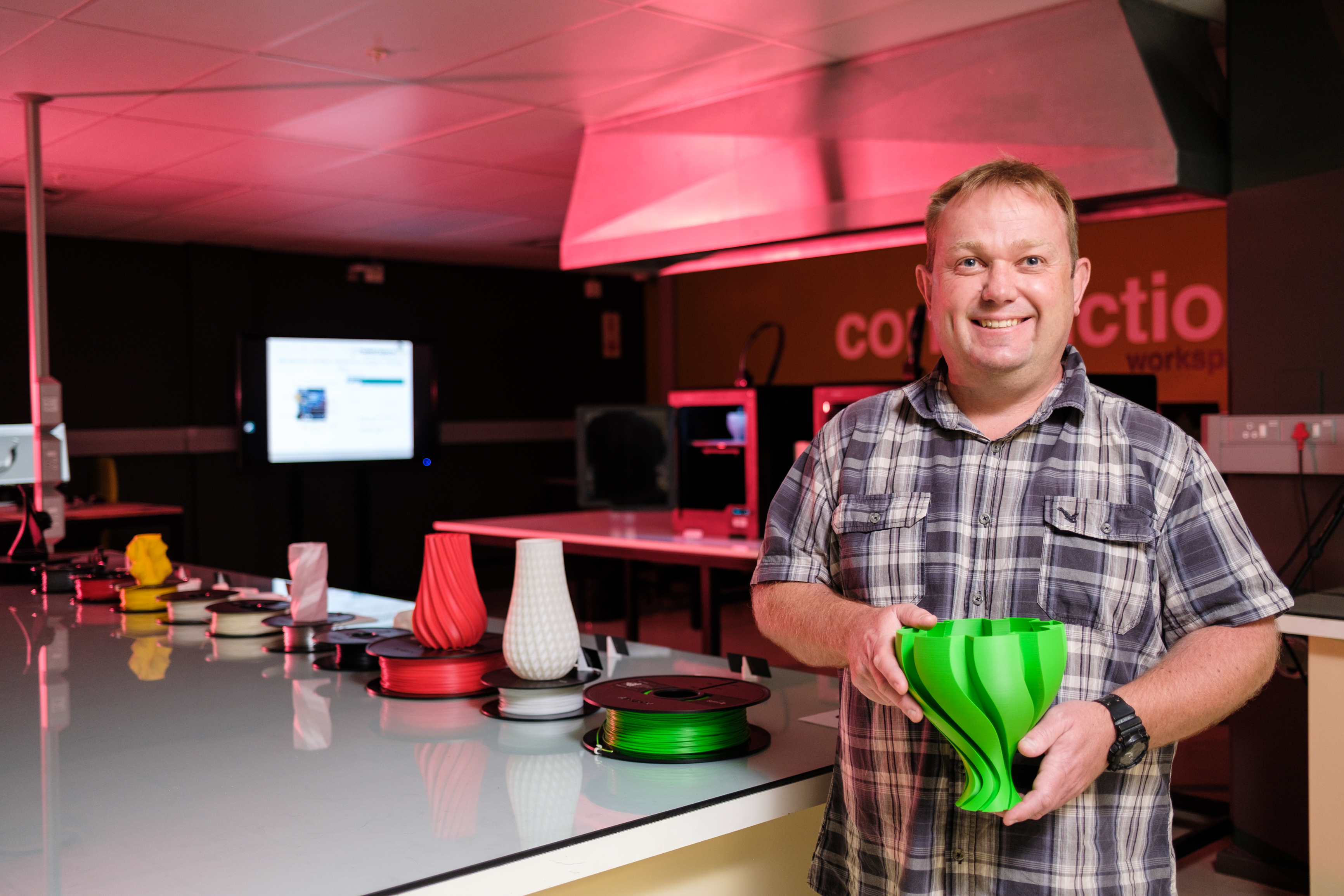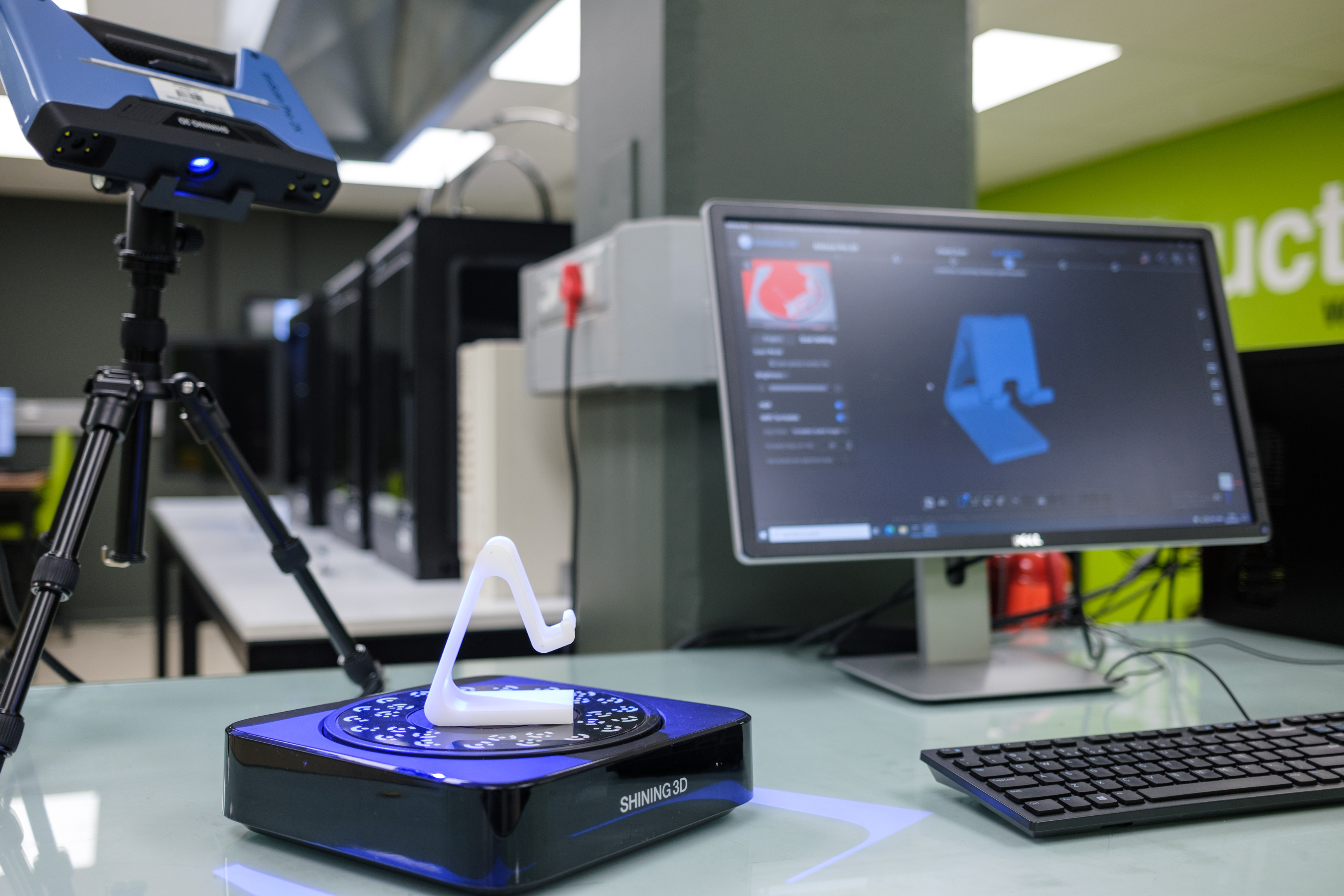A casing for a robot, a lightweight attachment to a drone, a wearable waterfall-like piece of clothing, a tailor-made motor engine part, a prototype for a water filter, the relief of Table Mountain and even a wedding ring and a Star Wars mask are among the ideas that have recently come to life thanks to the 3D printing and scanning equipment that are available to staff and students in the Stellenbosch University (SU) Library's new Makerspace.
The sky is the limit, and all depends on the ingenuity and imagination of their clients, says Norman Hebler, head of the recently launched Makerspace, situated on the upper level of the Library. He'd like to see the facility increasingly play an active role in helping inventors fine-tune and print prototypes of their designs, and to ensure that lecturers have tailor-made models at hand to show to their classes.
The facility is increasingly being used for research purposes. An MSc student in genetics, Cecilia Bester, has for instance used the state-of-the-art Einscan Pro 3D scanner as part of her efforts to create a virtual archive or museum of Southern African wild grain species, while another student printed a 3D model of a set of teeth.
Their clients do not only come from the engineering or sciences faculties, but also include creatives from, for instance, the Department of Visual Arts. Recently the Makerspace team helped jewellery students with the designs of new pieces and to print a semi-transparent artwork that another had envisaged.
Among the design software available to clients are the browser-based TinkerCad design program and the more advanced Fusion 360, as well as Rhino 3D, the industry standard in the jewellery world.
Hebler says that he also gladly oversees the printing of fun 3D projects of which the designs are freely available on the internet, as he sees it as a way of introducing people to the facility and its capabilities.
The Makerspace team guides students through the design and printing process itself, where need be. Training is provided for anything, from soldering to the use of Arduino Uno and Raspberry Pi when designing electronics. Such hardware, along with breadboards, are available for use in a design.
Workstations for more than just 3D modelling and, where needed, the circuit design of a project, are at the ready. Space for and advice about the assembly of different pieces are also provided.
Makerspace is in fact a well-stocked mini-workshop, with anything from the necessary screwdrivers and pliers to soldering equipment at the ready. Two construction workbenches with oscilloscopes are available, as well as four soldering stations and eight computer-aided design (CAD) computers.
Depending on the project at hand, students could also receive a basic toolkit so that they can work on their projects at home. Safety training is provided where need be.
Free service
The facility is available free of charge to registered SU students and staff.
“As a service provider, we run at cost. The only service we charge for is 3D printing, which is charged at between R2 and R3 per gram of materials being used," Hebler notes while demonstrating the wide selection of colours and different strengths of materials available for 3D printing.
The materials range from general consumer-grade to research-grade and are either resistant to UV rays, grease or chemicals.
A space to share ideas
But why such a facility in a library?
“The makerspace concept is a worldwide concept often found in universities and public spaces. The idea is that it should be a place where people can collaborate, share ideas, and focus on using specific types of technology," says Jeremiah Pietersen, manager: Learning and Training of SU's Library and Information Service.
He says the concept of imbedding such a creative space within an academic library evolved in the USA in the mid-2000s.
“It grew along with the whole concept of academic libraries as a space, rather than merely a book storage facility. It ties into the idea that a library is generally centrally placed on campus, and accessible by all students and staff. Think of it as a type of equity project, to make technology available to everyone and not only to those aligned to specific laboratories. It encourages the practicality of theory-based learning. It's about putting an idea into practice, so to speak," says Pietersen.
“One of our main functions is to get people involved, to let them start their learning process in this field, to give them the basics and to give them an idea of what is available out there," adds Hebler.
Guided tours for those interested in using the facility are available, as are introductory training sessions in anything from CAD, soldering, 3D printing and 3D scanning to the use of basic electronics thanks to the availability of Arduino Uno, Raspberry Pi or robotics.
For more information, visit https://libguides.sun.ac.za/makerspace
Captions: Norman Hebler, head of the recently launched Makerspace.
Photographer: Stefan Els

